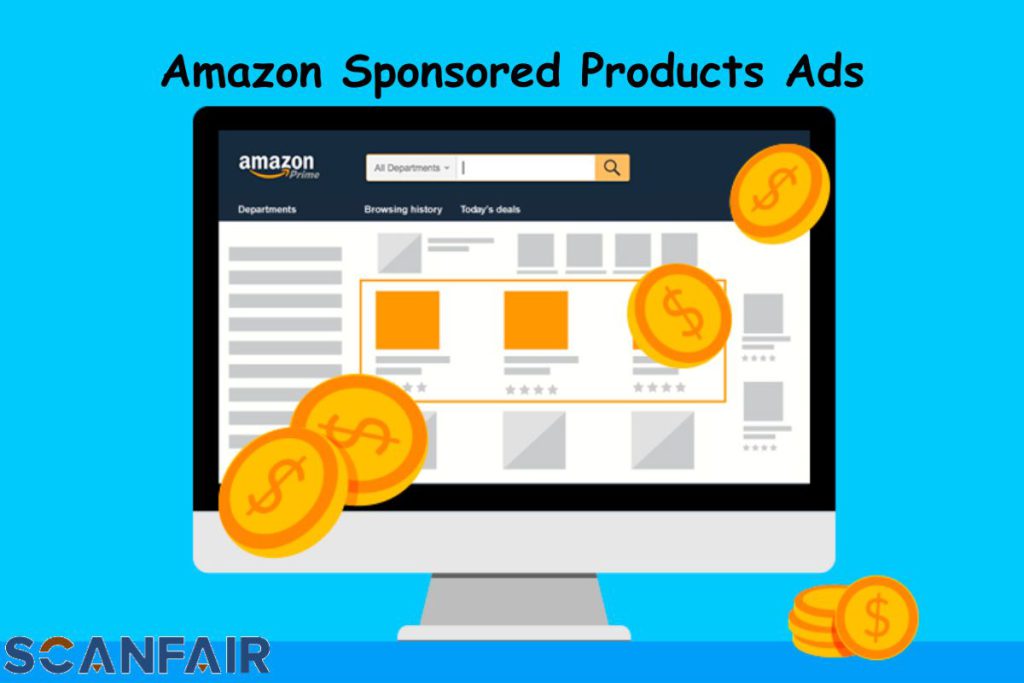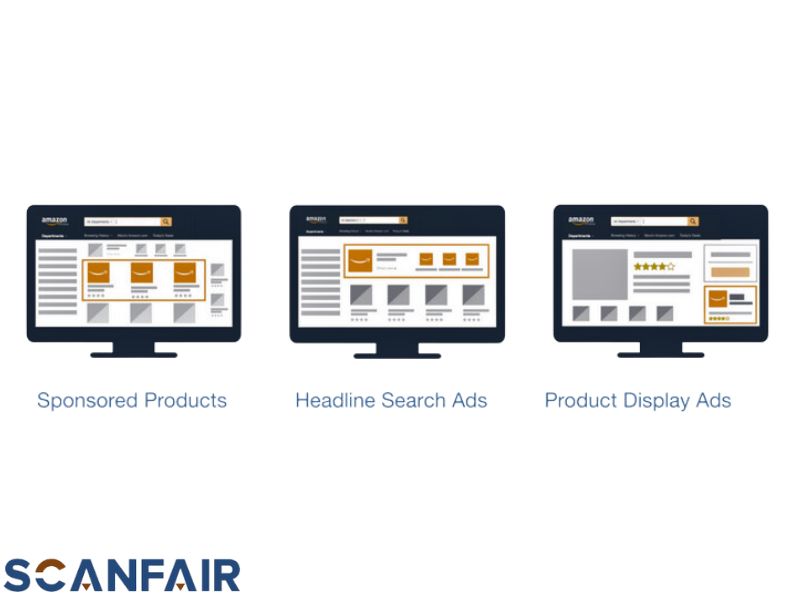In today’s highly competitive eCommerce landscape, standing out on platforms like Amazon is crucial for success. While having a great product and excellent customer service are foundational elements, you also need effective advertising strategies to reach a broader audience. Amazon Sponsored Ads is one such strategy that can significantly impact your business’s visibility and profitability.
In this comprehensive guide, we’ll delve deep into the world of Amazon Sponsored Ads. We’ll explore what they are, how they work, and most importantly, how you can leverage them to maximize your eCommerce success. By the end of this article, you’ll have a clear understanding of Amazon Sponsored Ads and the tools to create and optimize your own successful campaigns. The purpose of this Scan fair article is to teach Amazon Sponsored Ads
Understanding Amazon Sponsored Ads
Before we jump into the nitty-gritty of Amazon Sponsored Ads, let’s start with the basics. What are Amazon Sponsored Ads, and why are they essential for your eCommerce business?
What Are Amazon Sponsored Ads?
Amazon Sponsored Ads, often referred to as Amazon PPC (Pay-Per-Click), are a form of paid advertising on the Amazon platform. They allow sellers to promote their products to a more extensive and relevant audience by bidding on keywords and placements. When a user searches for a specific keyword related to your product, your ad can appear prominently in search results, on product detail pages, and even in other sellers’ product listings.
Why Are Amazon Sponsored Ads Important?
Amazon Sponsored Ads play a pivotal role in increasing your product’s visibility on the platform. Here are some key reasons why they are crucial for your eCommerce success:
Enhanced Visibility
With millions of products available on Amazon, standing out organically can be challenging. Sponsored Ads allow your products to appear at the top of search results, increasing their visibility to potential customers.
Targeted Reach
You can choose the keywords and products you want to target with your ads, ensuring that your products are shown to users actively searching for items similar to yours. This precision targeting can lead to higher conversion rates.
Increased Sales
By reaching a broader audience and optimizing your ad campaigns, you can drive more sales, ultimately boosting your revenue.
Data Insights
Amazon Sponsored Ads provide valuable data and analytics that can help you understand customer behavior, preferences, and the performance of your campaigns. This information is instrumental in refining your advertising strategy.
Types of Amazon Sponsored Ads
Amazon offers various types of Sponsored Ads to cater to different advertising objectives. Let’s explore these ad formats:
Sponsored Product Ads
Sponsored Product Ads are the most common type of Amazon Sponsored Ads. These ads promote individual products and appear within search results and on product detail pages. They look similar to organic product listings but are labeled as “Sponsored.”
Key Features of Sponsored Product Ads:
- Keyword targeting: You choose relevant keywords for your products.
- Cost-per-click (CPC) pricing: You pay only when a user clicks on your ad.
- Enhanced brand content: You can showcase your product’s unique features.
Sponsored Brand Ads
Sponsored Brand Ads are designed to promote your brand and create brand awareness. They often feature a custom headline, logo, and multiple products in a single ad. These ads typically appear at the top of search results.
Key Features of Sponsored Brand Ads
- Brand recognition: Increase visibility for your brand and products.
- Keyword targeting: Choose keywords relevant to your brand and products.
- Customizable creative: Design ads that represent your brand effectively.
Sponsored Display Ads
Sponsored Display Ads are intended to reach audiences both on and off Amazon. These ads can appear on Amazon product detail pages, customer reviews, and even external websites and apps. They help in retargeting and expanding your customer base.
Key Features of Sponsored Display Ads
- Audience targeting: Reach customers based on their interests, behaviors, and shopping history.
- Product targeting: Promote your products on relevant product detail pages.
- Custom ad creative: Create eye-catching ads to engage your audience.
Setting Up Your Amazon Sponsored Ads Campaign
Now that you have a solid understanding of Amazon Sponsored Ads and their types, it’s time to get your hands dirty and set up your first campaign. Follow these steps to create a successful Amazon Sponsored Ads campaign:
Define Your Advertising Goals
Before you launch a campaign, it’s crucial to establish clear objectives. Are you looking to increase sales, boost brand visibility, or drive traffic to your Amazon listings? Your goals will shape your campaign strategy.
Keyword Research
Keyword research is the foundation of your Amazon Sponsored Ads campaign. Start by identifying relevant keywords that potential customers might use to find products like yours. Use Amazon’s keyword research tools and consider long-tail keywords for more precise targeting.
Budget and Bidding Strategy
Determine your daily or monthly budget for the campaign. Amazon allows you to set a maximum daily budget to control your spending. Next, decide on your bidding strategy. You can choose between automatic and manual bidding:
Automatic Bidding
Amazon’s algorithm automatically adjusts your bids to maximize clicks within your budget. This option is suitable for beginners or those looking for a hands-off approach.
Manual Bidding
With manual bidding, you have more control over your bids. You can set different bid amounts for specific keywords and placements. This approach is best for experienced advertisers who want precise control.
Create Compelling Ad Creative
Your ad creative plays a significant role in attracting and engaging potential customers. Craft attention-grabbing headlines, informative ad copy, and high-quality images that showcase your product’s benefits.
Campaign Structure
Organize your campaign by creating ad groups based on product categories or types. This structure makes it easier to manage and optimize your ads. Each ad group should have its set of keywords and ad creative.
Monitor and Adjust
Launching your campaign is just the beginning. Regularly monitor its performance, analyze data, and make necessary adjustments. You may need to tweak your keyword selection, bids, or ad creative to optimize results.
Optimizing Your Amazon Sponsored Ads Campaign
Creating a campaign is only half the battle. To achieve long-term success with Amazon Sponsored Ads, continuous optimization is crucial. Here are some tips and strategies for optimizing your campaigns:
A/B Testing
A/B testing involves creating variants of your ads to determine which performs better. Test different ad headlines, images, and ad copy to discover what resonates most with your audience. Over time, you can refine your ads to maximize click-through rates and conversions.
Negative Keywords
Negative keywords are equally important as positive ones. These are keywords for which you don’t want your ads to appear. Adding negative keywords helps you refine your targeting and prevent your ads from showing to irrelevant audiences, ultimately saving your advertising budget.
Bid Management
Regularly review and adjust your bid strategy based on performance data. Increase bids for keywords that are driving sales and decrease bids for those with low conversion rates. Balancing your bids ensures you get the most out of your budget.
Ad Placement Optimization
Amazon Sponsored Ads allow you to choose where your ads appear. Analyze placement data to identify the most effective positions for your ads. You can adjust bids for top-of-search placement, product detail pages, and rest of search to maximize ROI.
Product Listing Optimization
Ensure that your product listings are fully optimized. High-quality images, detailed product descriptions, and positive customer reviews can influence a user’s decision to purchase. Well-optimized listings not only improve your organic rankings but also enhance the performance of your ads.
Seasonal Adjustments
Different seasons and holidays can impact consumer behavior. Be prepared to adjust your ad campaigns accordingly. Create seasonal ad campaigns, special offers, and promotions to align with peak shopping periods.
Measuring Success with Amazon Sponsored Ads
Measuring the success of your Amazon Sponsored Ads campaigns is vital to your ongoing strategy. Understanding key metrics and performance indicators allows you to make data-driven decisions and allocate your budget effectively. Here are some essential metrics to monitor:
Click-Through Rate (CTR)
CTR measures the percentage of users who click on your ad after seeing it. A higher CTR indicates that your ad is relevant and engaging to your target audience.
Conversion Rate
The conversion rate represents the percentage of users who complete a desired action, such as making a purchase, after clicking on your ad. A high conversion rate is a strong indicator of a successful campaign.
Return on Investment (ROI)
ROI measures the profitability of your advertising campaigns. It’s calculated by dividing your revenue generated from ads by the cost of running those ads. A positive ROI indicates that your campaigns are profitable.
Advertising Cost of Sales (ACoS)
ACoS represents the ratio of ad spend to the revenue generated from ads. Lower ACoS indicates efficient advertising spending, while a high ACoS may require adjustments to improve profitability.
Impressions
Impressions show how often your ads are displayed. While high impressions are good for visibility, it’s essential to balance this with other metrics like CTR and conversion rate to ensure your ads are driving meaningful engagement.
Clicks and Spend
Track the number of clicks your ads receive and the corresponding ad spend. Analyzing this data helps you assess the cost-effectiveness of your campaigns.
Keyword Performance
Regularly review the performance of your selected keywords. Identify high-performing keywords that drive sales and low-performing ones that may need adjustment or removal.
Troubleshooting and Common Challenges
Despite your best efforts, you may encounter challenges when running Amazon Sponsored Ads campaigns. Let’s address some common issues and how to troubleshoot them:
High ACoS
If your ACoS is higher than desired, consider adjusting your bids, targeting, or ad creative. Experiment with negative keywords to refine your audience and reduce irrelevant clicks.
Low Click-Through Rate (CTR)
A low CTR may indicate that your ad creative needs improvement. Test different ad variations to see what resonates with your audience. Ensure your keywords are highly relevant to your products.
Insufficient Data
In the early stages of your campaign, you may not have enough data to make informed decisions. Be patient and continue to optimize as you gather more data.
Stagnant Performance
If your campaigns plateau or decline in performance, consider refreshing your ad creative, expanding your keyword list, or exploring new product categories.
Competitor Challenges
Competitors can be aggressive in the Amazon marketplace. Keep an eye on your competition, and adjust your strategies accordingly. This may include increasing bids for high-value keywords or offering promotions to stay competitive.
Advanced Strategies for Amazon Sponsored Ads
Once you’ve mastered the basics of Amazon Sponsored Ads, you can explore advanced strategies to further enhance your campaigns:
Scaling Campaigns
As your business grows, consider scaling your campaigns to reach a broader audience. Expand your keyword lists, create more ad groups, and explore new ad formats to increase your reach.
Sponsored Brand Video Ads
Amazon offers the option to create video ads for brand campaigns. These engaging ads can help you tell your brand’s story and connect with customers on a deeper level.
Amazon DSP (Demand-Side Platform)
Amazon DSP allows you to run display and video ads both on and off the Amazon platform, providing advanced targeting options and broader reach.
External Traffic
Consider driving external traffic to your Amazon listings through social media, email marketing, and other channels. This can help boost your organic ranking and overall sales.
Adherence to Amazon’s Advertising Policies
It’s essential to adhere to Amazon’s advertising policies to avoid potential issues and ensure a smooth advertising experience. Familiarize yourself with Amazon’s guidelines on product listings, ad content, and prohibited practices.
Conclusion
Amazon Sponsored Ads are a powerful tool for boosting your eCommerce success on the world’s largest online marketplace. By understanding the fundamentals, implementing effective strategies, and continually optimizing your campaigns, you can achieve higher visibility, increased sales, and sustainable growth for your business.
Remember that success with Amazon Sponsored Ads requires ongoing commitment and a willingness to adapt to changes in the platform and market. Stay informed about the latest advertising trends and best practices to maintain your competitive edge.



